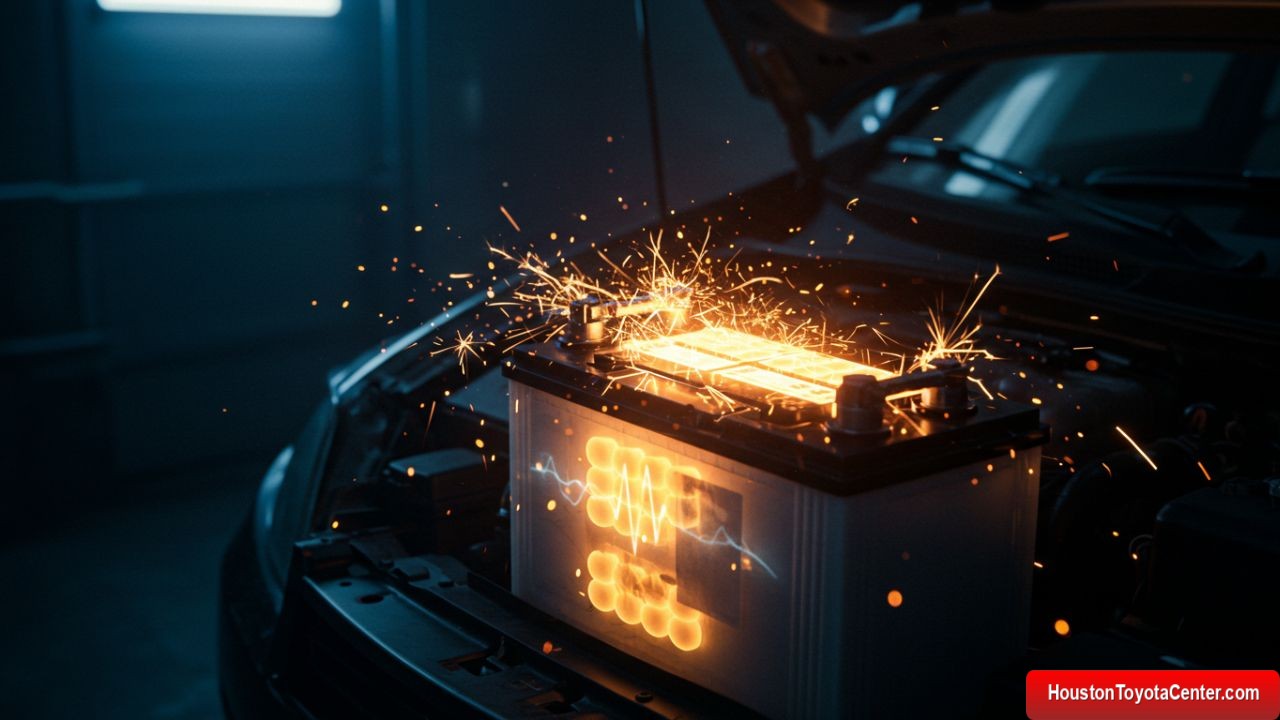When your car refuses to start or your lights dim unexpectedly, chances are your battery is trying to tell you something. The automotive battery is a critical component of your vehicle—without it, your engine won’t crank, your electronics won’t work, and you could find yourself stranded in the middle of nowhere.
This comprehensive guide dives deep into battery testing, charging, and understanding when replacement is necessary. Whether you’re a DIY enthusiast, a new driver, or just want to understand your car better, this is your go-to resource.
🔧 What Does a Car Battery Actually Do?
A car battery is more than just a storage box for electricity. It’s a powerhouse of energy, supplying the required voltage to start your car and run the vehicle’s electrical systems when the engine is off.
🔋 Key Functions of a Car Battery:
- Starts the engine: Provides the electrical current to the starter motor.
- Stabilizes voltage: Keeps the voltage consistent throughout the electrical system.
- Powers electronics: Supports lights, audio systems, computers, and more.
🧪 How to Test a Car Battery (DIY and Professional Methods)
Regular testing helps you catch battery problems before they leave you stranded. You can test your battery at home with a multimeter or take it to a professional shop for a load test.
FREE: Quickly identify and understand problems with your vehicle 🚘
CLICK HERE🔍 At-Home Testing with a Multimeter
- Turn off the engine and electronics.
- Set your multimeter to DC voltage.
- Connect the positive lead to the battery’s positive terminal.
- Connect the negative lead to the negative terminal.
- A healthy battery should read between 12.4 and 12.7 volts.
| Voltage Reading | Battery Condition |
|---|---|
| 12.6V or more | 100% charged |
| 12.4V | 75% charged |
| 12.2V | 50% charged |
| 12.0V or lower | Discharged or failing 🔻 |
🧪 Professional Load Testing
A load tester simulates the battery’s workload to see how it performs. It can uncover issues that a voltage test might miss, especially under stress. Most auto parts stores offer free battery load testing.
🔌 Charging a Car Battery the Right Way
Batteries lose charge due to cold weather, short trips, or long periods without use. Here’s how to recharge safely.
⚠️ Important Before Charging:
- Make sure the battery is not damaged or leaking.
- Always wear gloves and goggles.
- Ensure the charger is compatible with your battery type (AGM, flooded, gel).
🔋 How to Use a Manual Battery Charger:
- Connect the red clamp to the positive terminal (+).
- Connect the black clamp to the negative terminal (−).
- Plug in and turn on the charger.
- Set the charge rate (2A for slow charge, 10A for fast charge).
- Monitor until the battery reaches 12.6–12.7V.
⚡ Charging While Driving
Modern alternators charge the battery as you drive. However, short trips under 15 minutes may not be enough. If your car sits for long, invest in a trickle charger or solar charger to maintain charge.
🛑 Signs It’s Time to Replace Your Car Battery
Batteries have a lifespan of 3–5 years, but that can be shorter depending on conditions. Recognizing the warning signs early can prevent breakdowns.
🚩 Common Warning Signs:
- Engine cranks slowly or inconsistently.
- Headlights dim when idling.
- Clicking sound when turning the key.
- Swollen or cracked battery case.
- Corrosion on terminals.
- Check battery light on the dashboard.
- Need to jump-start frequently.
🗓️ Battery Lifespan: What Affects It?
Several factors influence how long a battery lasts:
| Factor | Impact on Battery Life ⚡ |
|---|---|
| Climate | Heat accelerates fluid loss and corrosion. ❄️ Cold slows chemical reactions. |
| Driving Habits | Short trips = less charging time. 🚗💨 |
| Electrical Load | High demands from electronics drain battery. 📱🔊 |
| Maintenance | Corrosion and loose terminals reduce lifespan. 🧼🔩 |
🛠️ How to Replace a Car Battery (Step-by-Step)
Changing a car battery is a straightforward process. Follow these steps carefully:
🔧 Tools You’ll Need:
- Wrench set
- Battery terminal cleaner or brush
- Gloves and safety glasses
- New battery (correct group size & type)
🪛 Step-by-Step Instructions:
- Turn off the engine and remove keys.
- Disconnect the negative terminal first, then the positive.
- Remove the hold-down clamp or bracket.
- Lift the old battery out (they’re heavy!).
- Clean the terminals and tray.
- Install the new battery, securing it properly.
- Connect the positive terminal first, then the negative.
- Check for a snug fit and test the ignition.
⚠️ Pro Tip:
Never mix up positive and negative connections. Doing so can cause serious electrical damage.
🔌 Battery Maintenance Tips for Longer Life
Keeping your battery in top condition ensures performance and saves money.
💡 Maintenance Checklist:
✅ Check battery terminals monthly for corrosion.
✅ Clean terminals with baking soda and water if needed.
✅ Ensure cables are tight and secure.
✅ Drive your vehicle regularly to maintain charge.
✅ Avoid leaving lights or electronics on while parked.
✅ Use a battery maintainer if your vehicle sits idle for weeks.
🔋 Choosing the Right Battery for Your Vehicle
Not all batteries are created equal. Here’s how to choose the right one:
🧾 Consider These Factors:
- Battery Group Size (fit your vehicle’s tray)
- Cold Cranking Amps (CCA): Ability to start in cold weather
- Reserve Capacity (RC): Time the battery runs on its own power
- Battery Type: Flooded, AGM, Gel
| Battery Type | Pros | Cons |
|---|---|---|
| Flooded Lead-Acid | Cheapest, widely available | Requires maintenance, prone to spillage |
| AGM (Absorbent Glass Mat) | Maintenance-free, high power | More expensive |
| Gel | Long-lasting, deep discharge cycles | Sensitive to overcharging |
🔋 Battery Myths vs. Facts
Let’s debunk some of the most common battery myths:
| Myth | Reality ✅ |
|---|---|
| You can test a battery just by looking at it | Voltage and load testing are required |
| If your car starts, the battery is fine | It might still be weak or deteriorating |
| Premium batteries last forever | All batteries degrade with time |
| Jump-starting fully recharges a battery | It helps start the car, but doesn’t fully charge |
| Cold weather kills batteries instantly | It slows them down, but age is the real culprit |
🚗 Should You Choose a Professional or DIY Battery Service?
| Option | Advantages | Disadvantages |
|---|---|---|
| DIY | Cost-effective, quick | Safety risk, wrong installation, heavy lifting |
| Professional | Diagnostic services, warranty, eco-disposal | More expensive |
In many cases, auto parts stores like AutoZone, O’Reilly, or NAPA offer free installation if you buy the battery from them—worth considering.
♻️ What to Do with Your Old Battery?
Old batteries should never go in the trash. They contain lead and acid that harm the environment.
✅ Eco-Friendly Disposal Options:
- Take it to the auto parts store when buying a new one.
- Drop it off at a local recycling center.
- Many stores offer a “core refund” if you return your old battery.
🧠 Final Thoughts: Be Battery Smart
Being proactive about your car battery can save you from expensive tows and lost time. With just a few simple habits and timely checks, you can extend the life of your battery and avoid unpleasant surprises.
✔️ Test it.
🔌 Charge it.
🔁 Replace it when needed.
♻️ Recycle it properly.
Your battery doesn’t last forever—but your knowledge will.
✅ TL;DR Battery Cheat Sheet
| Task | Frequency | Tools |
|---|---|---|
| Voltage Test | Every 3 months | Multimeter |
| Clean Terminals | Every 6 months | Brush + Baking Soda |
| Check Charging System | Annually | Mechanic or OBD Tool |
| Replace Battery | Every 3–5 years | Yourself or Mechanic |


Leave a Reply